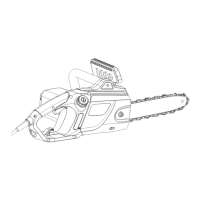34
TTL758CHN
In
more
detail...
EN
Operation
Limbing and pruning
Limbing is removing the branches
from a fallen tree. When limbing
leave larger lower limbs to
support the log o the ground.
Remove the small limbs in one
cut (Fig. 10). Branches under
tension should be cut from the
bottom up to avoid binding the
product.
7. Felling back cut
1). Make the felling back cut (Fig. 9b, A) at least 50 mm higher than
the horizontal notching cut (Fig. 9b). Keep the felling back cut
parallel to the horizontal notching cut. Make the felling back cut
so enough wood is left to act as a hinge. The hinge (Fig. 9b,
C) wood keeps the tree from twisting and falling in the wrong
direction. Do not cut through the hinge.
2). As the felling gets close to the hinge, the tree should begin to
fall. If there is any chance that the tree may not fall in desired
direction or it may rock back and bind the saw chain, stop cutting
before the felling back cut is complete and use wedges of wood,
plastic or aluminium to open the cut and drop the tree along the
desired line of fall.
3). When the tree begins to fall remove the product from the cut,
stop the motor, put the product down, then use the retreat path
planned. Be alert for overhead limbs falling and watch your
footing.
Fig. 10
WARNING! Never climb into a tree to limb or prune! Do not
stand on ladders, platforms, logs, or in any position which
may cause you to lose the balance or control of the saw!
When pruning trees, it is important not to make the ush
cut next to main limp or trunk until you have cut o the limb
further out to reduce the weight! This prevents stripping the
bark from the main member!
WARNING! If the limbs to be pruned are above chest height,
hire a professional to perform the pruning!

